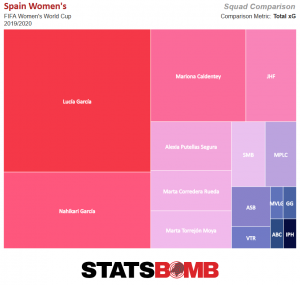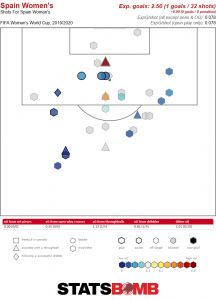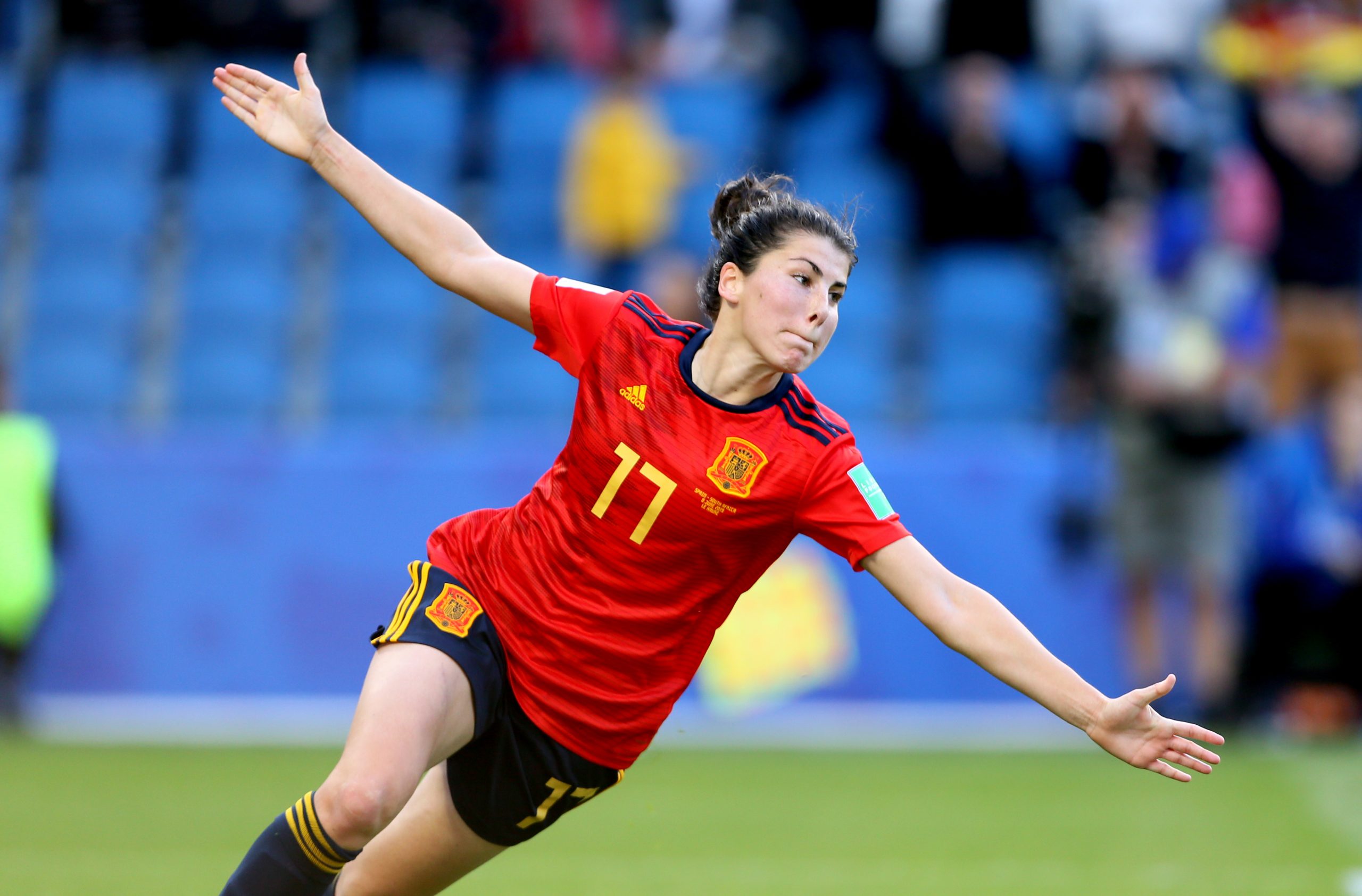When Spain crashed out of the 2015 Women’s World Cup at group stage and after failing to win a game, it accelerated a revolution that was simmering within women’s football in the country. Before being split onto two flights for the return from Canada, the team presented an open letter to the Royal Spanish Football Federation (RFEF), calling for change and for the end of Ignacio Quereda’s 28 year tenure as the coach. Stories of Quereda’s dismissive and sexist behaviour, his archaic training methods and the lack of any opposition scouting were leaked to trusted journalists who had been stalwart followers of women’s football. By the time the planes landed in Madrid, the media was rife with stories and scandal. The players presented a united group in front of the cameras. As had happened to players before them, they knew that speaking out could cost them their positions in the team, but enough was enough. The media and public outrage was too great for the RFEF to contain. It was well known that then President Ángel María Villar had little interest in women’s football, but even he couldn’t sweep this mess under the carpet and pretend that nothing had happened. Quereda resigned before he was dismissed, and Jorge Vilda was appointed as the new coach. Vilda is a purebred. His father Ángel worked as a fitness trainer for some of the best coaches in La Liga (such as Luis Aragonés, Johan Cruyff, Jupp Heynckes and José Mourinho) and his son was always around the teams and managers as he grew up. Vilda Snr. was then employed by the RFEF as coach of the Spanish women’s U19 team. Jorge also came onboard to coach the U17 women. The Vildas – Ángel in particular – were respected and loved by the players that they coached, and the results began to reflect their hard work and input into the Spanish women’s game, as medals were won at youth level UEFA European Championships and FIFA World Cups. Shockingly, Vilda Snr.’s contract was not renewed by the RFEF in 2015. The official statement was that the Federation was looking to “inject younger blood at coaching level”. Ironically, Ángel was 65 at the time and Quereda was 62, but somehow the latter remained in his position – for a few months, at least, until the senior women’s team called for change. The changes came. Vilda Jr. took over and 10 senior players on the team were either immediately dropped or marginalised into secondary roles for the next year, before not being selected again. The official stance for their non-selections was that they were for “technical reasons”, but given that some of these players were (and still are) performing at high levels, that seemed to be a far-fetched excuse. Since taking over, Vilda has retained a core squad and tinkered with the lineups by calling in new players on an irregular basis, and only when incumbent players were unavailable. The new players have barely enough time to settle in before being ousted again. However, several youth team players have made the jump to senior level in Vilda’s time – Mariona Caldentey, Patri Guijarro, Aitana Bonmatí, Lucía García, Andrea Falcón and Nahikari García – all of whom are in the current World Cup squad playing in France. Lucía García and Nahikari García are Spain's top two expected goals leaders  When Vilda announced his 2019 squad for Spain’s second appearance at a Women’s World Cup, there were howls of disbelief as 2 of the season’s top Liga performers, Ángela Sosa and Esther González, were omitted. Both these players are capable of shooting from outside the box and taking every opportunity that is presented to them to have a shot at goal. This is certainly something that is missing from this Spanish selection, but that’s nothing new if you’ve watched any Spanish football for at least the past 10 years. The Spain game is based on possession, meaning “if we have the ball, then you don’t”. However, possession is meaningless without intent, and the Spanish women’s team is not alone in playing incredible passing football that can make a viewer gasp out loud at its beauty, but also groan in frustration that there is no one willing to take a shot on goal. It’s almost as if Spanish players think that they can’t take a shot unless they are in the box with at least a 90% success rate of getting the ball into the net. Unsurprisingly, Spain have attempted the third-most passes in the final third of the tournament, after the United States and the Netherlands. The games against South Africa and Germany have seen Spain retain possession and the team looks particularly strong in midfield with Virginia Torrecilla the standout player and Aitana Bonmatí playing a strong cameo role. The defence is doing reasonably well too – centre-back Mapi León is the standout player there. The danger attacking players – Jenni Hermoso, Lucía García and Nahikari García – are producing some fine opportunities with little reward to show for it, thus far. The attacking statistics are woeful. Of the three goals scored, only one has been from open play with the other two from the penalty spot. Shots are being taken but mostly off target or straight at the Keepers, so Spain still has a lot of work to do up front in the areas of accuracy and opportunity. Spain have had 32 shots from open play in their opening two games, but only nine have been on target (a fairly poor 28%).
When Vilda announced his 2019 squad for Spain’s second appearance at a Women’s World Cup, there were howls of disbelief as 2 of the season’s top Liga performers, Ángela Sosa and Esther González, were omitted. Both these players are capable of shooting from outside the box and taking every opportunity that is presented to them to have a shot at goal. This is certainly something that is missing from this Spanish selection, but that’s nothing new if you’ve watched any Spanish football for at least the past 10 years. The Spain game is based on possession, meaning “if we have the ball, then you don’t”. However, possession is meaningless without intent, and the Spanish women’s team is not alone in playing incredible passing football that can make a viewer gasp out loud at its beauty, but also groan in frustration that there is no one willing to take a shot on goal. It’s almost as if Spanish players think that they can’t take a shot unless they are in the box with at least a 90% success rate of getting the ball into the net. Unsurprisingly, Spain have attempted the third-most passes in the final third of the tournament, after the United States and the Netherlands. The games against South Africa and Germany have seen Spain retain possession and the team looks particularly strong in midfield with Virginia Torrecilla the standout player and Aitana Bonmatí playing a strong cameo role. The defence is doing reasonably well too – centre-back Mapi León is the standout player there. The danger attacking players – Jenni Hermoso, Lucía García and Nahikari García – are producing some fine opportunities with little reward to show for it, thus far. The attacking statistics are woeful. Of the three goals scored, only one has been from open play with the other two from the penalty spot. Shots are being taken but mostly off target or straight at the Keepers, so Spain still has a lot of work to do up front in the areas of accuracy and opportunity. Spain have had 32 shots from open play in their opening two games, but only nine have been on target (a fairly poor 28%).  To Vilda’s credit, he reacted early in the game against South Africa, making changes at the beginning of the second half which saw the team more fluid and dynamic. After the match, Jenni Hermoso commented that “she liked Nahikari García on the pitch” for the danger and opportunities that she creates – perhaps a subtle pot shot at Vilda’s lineup choices. Vilda adjusted the lineup again for the Germany game and it almost worked except for a massive defensive error which allowed Germany a squeaky 1-0 win, but again the Spanish attack was not accurate enough in front of goal, and Vicky Losada would have been a better choice in midfield instead of Silvia Meseguer. The final group game will be against China, and Spain will be keen to win the game to finish second in Group B, or at least be one of the 4 best third-placed teams in order to qualify for the knockout rounds. The milestones are coming for the team, and this tournament has already seen them win their first-ever World Cup game (against South Africa). Getting out of the group stage will be the next aim, where they will play either the USA (if they finish second in Group B), or England (if they qualify in third). Unless Spain gets their shooting boots on, it will be difficult to see them progressing beyond the round of 16 where they will be confronted with two strong opponents. Spanish women’s football is on an upwards trajectory, particularly in the age group categories in which both the U17 and U19 teams won their Euro competitions last year, the U17s won the World Cup in Uruguay and the U20s were runners-up at the World Cup in France. We haven’t yet seen the best of what Spain has to offer in attack. There are younger forwards coming through that have a more direct style – players such as Eva Navarro, Clàudia Pina and Salma Paralluelo. When combined with incumbent players such as Guijarro, Bonmatí, Lucía García and Nahikari García, we will see a more dynamic Spanish attack to complement the possession game. The bigger question will be if it will be Jorge Vilda that will manage the next transition for the Spanish La Absoluta. There are already rumblings of dissatisfaction that he is not selecting the best of the available players, instead playing favourites, and not properly utilising the players that he is choosing. There is also a question about how he can be the Spanish Women’s Technical Director as well as the coach of the Spanish senior team – something which in their Technical Director’s Report, FIFA strongly advises against, because that is too much influence from one person in power. Should Vilda step down, there is a huge desire within the Spanish WoFo community that the next coach be a woman, and there are at least five or six very strong candidates that could take his place, beginning with U17 coach Toña Is. However, that’s in the future. In the meantime, the fans are celebrating each success, mindful of how far the Spanish women have come since the brave generation of players stood strong in 2015 and demanded change – ten of them to the detriment of their own careers. Spanish women’s football will be forever indebted to them.
To Vilda’s credit, he reacted early in the game against South Africa, making changes at the beginning of the second half which saw the team more fluid and dynamic. After the match, Jenni Hermoso commented that “she liked Nahikari García on the pitch” for the danger and opportunities that she creates – perhaps a subtle pot shot at Vilda’s lineup choices. Vilda adjusted the lineup again for the Germany game and it almost worked except for a massive defensive error which allowed Germany a squeaky 1-0 win, but again the Spanish attack was not accurate enough in front of goal, and Vicky Losada would have been a better choice in midfield instead of Silvia Meseguer. The final group game will be against China, and Spain will be keen to win the game to finish second in Group B, or at least be one of the 4 best third-placed teams in order to qualify for the knockout rounds. The milestones are coming for the team, and this tournament has already seen them win their first-ever World Cup game (against South Africa). Getting out of the group stage will be the next aim, where they will play either the USA (if they finish second in Group B), or England (if they qualify in third). Unless Spain gets their shooting boots on, it will be difficult to see them progressing beyond the round of 16 where they will be confronted with two strong opponents. Spanish women’s football is on an upwards trajectory, particularly in the age group categories in which both the U17 and U19 teams won their Euro competitions last year, the U17s won the World Cup in Uruguay and the U20s were runners-up at the World Cup in France. We haven’t yet seen the best of what Spain has to offer in attack. There are younger forwards coming through that have a more direct style – players such as Eva Navarro, Clàudia Pina and Salma Paralluelo. When combined with incumbent players such as Guijarro, Bonmatí, Lucía García and Nahikari García, we will see a more dynamic Spanish attack to complement the possession game. The bigger question will be if it will be Jorge Vilda that will manage the next transition for the Spanish La Absoluta. There are already rumblings of dissatisfaction that he is not selecting the best of the available players, instead playing favourites, and not properly utilising the players that he is choosing. There is also a question about how he can be the Spanish Women’s Technical Director as well as the coach of the Spanish senior team – something which in their Technical Director’s Report, FIFA strongly advises against, because that is too much influence from one person in power. Should Vilda step down, there is a huge desire within the Spanish WoFo community that the next coach be a woman, and there are at least five or six very strong candidates that could take his place, beginning with U17 coach Toña Is. However, that’s in the future. In the meantime, the fans are celebrating each success, mindful of how far the Spanish women have come since the brave generation of players stood strong in 2015 and demanded change – ten of them to the detriment of their own careers. Spanish women’s football will be forever indebted to them.
2019
Spain's World Cup showing belies a true revolution
By admin
|
June 14, 2019
